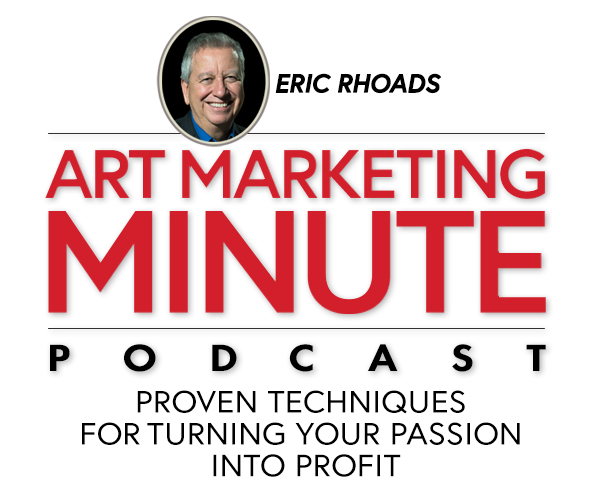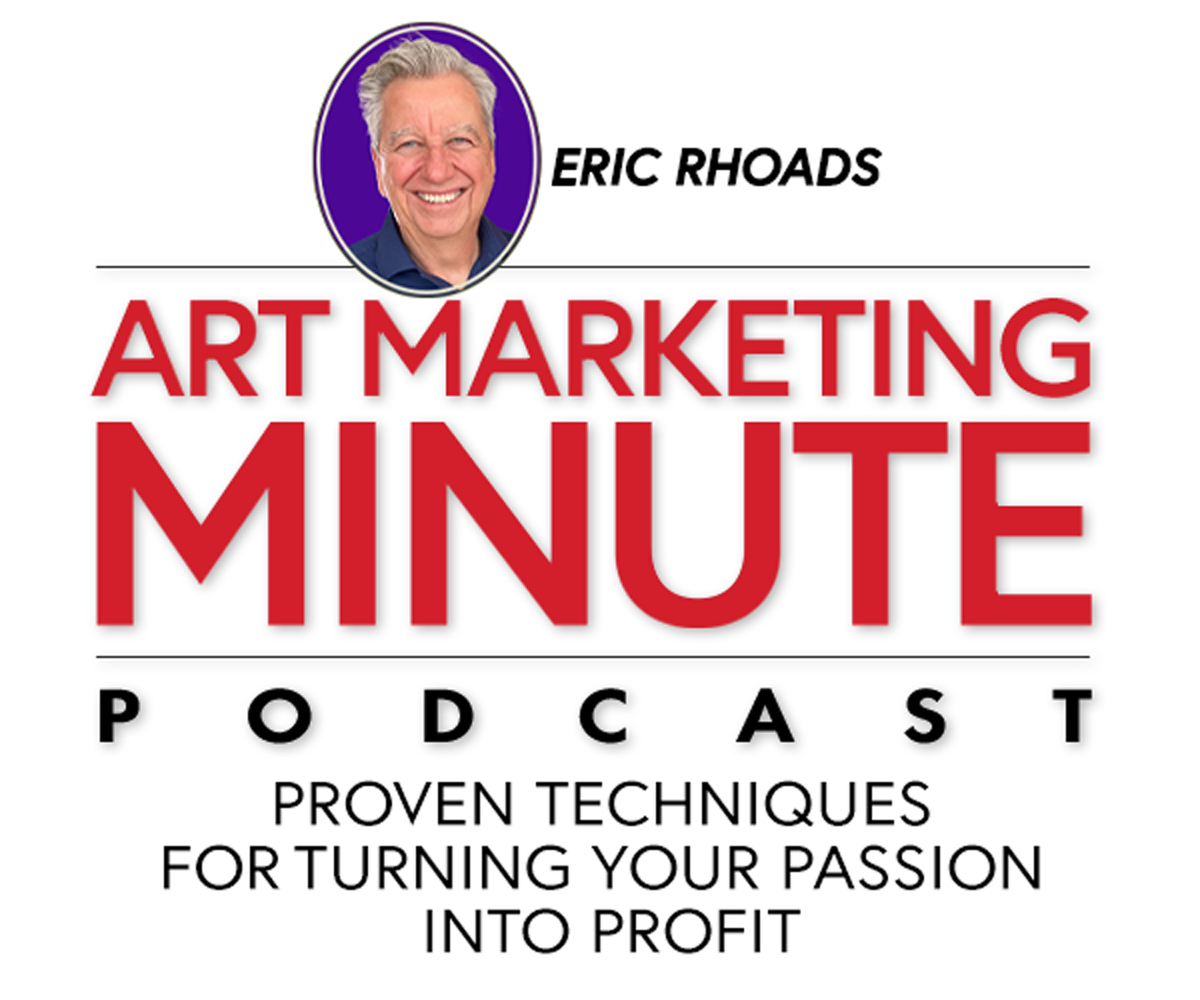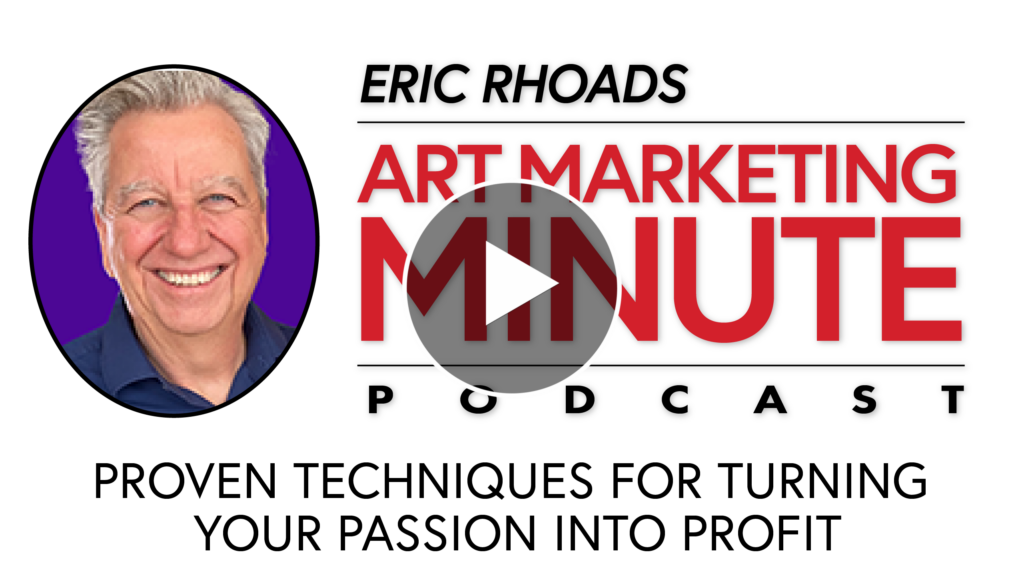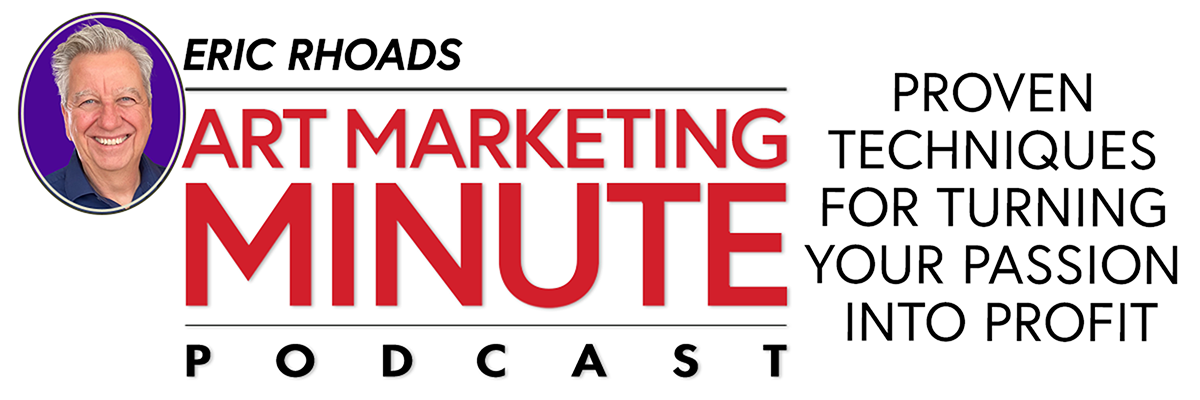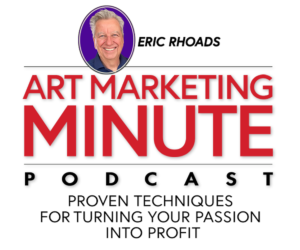Art Marketing Minute Podcast: Episode 127
In the Art Marketing Minute Podcast, you’ll learn how to sell your art, how to market your paintings, and everything else you need to know in order to have a successful art career.
In this week’s Art Marketing Minute, Eric Rhoads, author of Make More Money Selling Your Art, discusses the best place to begin to market your art; and what not to do to drive up your prices.
The Art Marketing Minute Podcast has been named one of the 2023 “Top 25 Art Business and Marketing Blogs on the web” by FeedSpot.
Listen to the Art Marketing Minute Podcast: Episode 127 >
Submit Your Art Marketing Question:
What questions do you have about selling your art? Visit artmarketing.com/questions or e-mail Eric at [email protected] (include your name and where you’re from) to hear your question answered on an upcoming Art Marketing Minute Podcast.
FULL TRANSCRIPT of the Art Marketing Minute:
DISCLAIMER: The following is the output of a transcription from an audio recording of the Art Marketing Minute. Although the transcription is mostly correct, in some cases it is slightly inaccurate due to the recording and/or software transcription.
Announcer:
This is the Art Marketing Minute with Eric Rhoads, author of the Amazon best-selling book, “Make More Money Selling Your Art.” In the marketing minute, we answer your questions to help your art career brought to you by artmarketing.com, the place to go to learn more about marketing. Now, here’s your host, art magazine publisher, Eric Rhoads.
Eric Rhoads:
So the goal if you want to make a living as an artist is to figure out how to do it. And it’s unfortunately it’s not just like the what was that Field of Dreams. If you build it, they will come. It’s not true. If you paint it, they won’t come you have to invite people in you have to learn marketing to do that. It doesn’t have to be harsh. It doesn’t have to be sleazy or greasy or salesy, but it is a good skill to learn because otherwise, you’ll have skinny kids. So the first question comes from Patricia Tabor Perry, in Massachusetts. And the question is simple one, where is the best place to begin to market your art? You know, that’s a that’s a loaded question, Patricia, because there’s so many answers to that. I think, first off, I think a very first piece of this is to find out if you’re ready. I, I certainly wasn’t ready when I started marketing my art. And I struggled with that. Because you know, it’s it’s kind of like, if you’re, you’re manufacturing a product and your product isn’t good, you’re gonna have a hard time selling it, you know, so you got a car where the doors don’t work, you know, nobody’s gonna buy it. And so I like to I like the idea of getting some advice. So find some trusted advisors, who will tell you the truth. And the way I have always approached it is I don’t want you to say anything good. I want you to tell me the bad stuff, because I need to know what I’ve got to work on what I’ve got to fix. And ultimately, the question is, am I ready? Now there’s different levels of people, right? So if you were to ask Cindy Baron, for instance. You know, she’s at a very, very high level know, she’s a very generous person, and she will, you know, be very kind to you. But, you know, her standards are high. And someone else who asked their standards might not be as high. So you want to ask people who have standards that are high, because I think that’s important. Now, you might not, you know, you might go out there anyway, because you might not get to that level right away. But one thing I like to do is ask gallery owners and I did this recently, I sent a picture of a painting to a friend of mine who’s a gallery owner. I said, Listen, I have no intention of asking you to go into your gallery. Because I this is not a ploy to have you secretly discover what a great painter I am. I just said, I, I don’t know if this is ready, and I don’t I need some feedback. And he was very generous. Now you have to do it with somebody you know, and trust if you can. And he was very generous and he gave me some really great feedback, some things that I couldn’t see. And that’s the nice thing and I have friends that I will contact that I paint with. And I’ll send them an image when I’m painting I’ll say something’s not right. But I can’t tell what it is. And you know, somebody will say, well move that tree. I was doing a self portrait. And Max Ginsburg said, Well, you know, there, you’re missing. You’re missing the enough darks on this side of the face if you just change that one thing, and he was completely right, and so but I couldn’t see it. So look for somebody to give you feedback. Now, the other thing you’ve got to do is start with some questions. The questions you got to ask yourself is why do you want to market your art? What what is your purpose? You know, I did some coaching at fall color week, one year, because it was snowing and nobody wanted to go out. And so I killed some time by offering some coaching one on one with some people. And a couple of people said, you know, I want to sell my art. And I said, why? And they said, I don’t know. Cuz everybody’s supposed to do that. I said, Well, that’s not true. I said, Do you need the money? And in two cases, they said, No, I don’t need the money. I have plenty of money, I retired, I put my money away. I said, Well, why do you want to sell your art? And then they realized, well, it was really about recognition. And they wanted that validation that somebody was willing to pay for it. I said, Well, can you get that validation some other way? Like, could you get it by donating your art or charity auctions or things that others will appreciate it, but you don’t have to feel like you have the pressure of marketing and selling your art and advertising? And so that resonated with those people, but you got to figure out why do you want to do it? What do you want to accomplish? Why do you want to sell it isn’t about money? Do you want to make a living? If it’s you want to make a living? How much of a living Do you want to make? You know, do you want to replace the income you have? Now, you know, if you’re a heart surgeon, and you’re making, I don’t know how much heart surgeons make, but you’re making that much money? I’ll go talk to a heart surgeon today and find out. They’re never going to tell me the but the idea is, is that a little money is a lot of money. Is it a retirement income? Is it a full time gig that influences all of the things that you’re going to have to figure out? You know, what about recognition? How important is that, that validation? And then you know, you dig into those things and try to understand what it is you really want to accomplish, because a lot of people chase rainbows that they don’t really want to chase and they get there and they go, Oh, right. And, you know, I’m really busy. And I don’t like being busy. You know, so find it, talk to other artists find out what their life is, like, you know, if you say, Well, I want to do I want to be like this artist or that, like artists call that artists and say, Hey, what’s your life? Like, you know, and they’re, they’re like, Well, you know, I’m on the road seven months a year doing plein air shows, and I never see my family. And you know, it’s a hard way to make a living. I like it. I love it. But, you know, are you willing to do that, so you got to be thinking about those things in terms of once you get beyond all of that, then you’re going to have to think about, you know, how do I ease into this? What’s my strategy? You know, I think just start small, start easy do tests, I love tests, you know, like, a really great way to start is just to do a little art show, you know, local cafe, local restaurant, go to the owner, set something up, give them a piece of it, if they need that, you know, the goal is to just find out, you know, this isn’t always about making money. It really never is, that’s a side benefit, I think because you do what you love, and the money will typically follow. But there are things that you have to do disciplines you have to do so start small, do a little business, a little art show in a business or a cafe or something, try that or maybe you know, try a little gallery test, you know, maybe there’s a community gallery you can try out or maybe you know, you start talking to galleries, but I would find out first if your work is marketable before you do that, see what works. And then kind of start there. You know, the, the ultimate answer to that question that I always say in my art Marketing Bootcamp, is I talk about okay, very first thing you do is you start building your list, because if you build a list, then you can get more contact with people. As you know, somebody signs up for your newsletter, you give them an incentive to do that, and so on.
Now, the next question is from Emily Feeney in Illinois, would publishing the name of high profile buyers drive up prices? Well, Emily, I’m going to tell you a little bit of a story. I had a really wonderful artists friend in Carmel, who had her own gallery, and she had a lot of famous people who bought paintings. And she would take pictures with those people, and she would blow them up and frame them and put them in the gallery. And that was an implied endorsement. It said, well because Pierce Brosnan or Oprah Winfrey or Tom Cruise or somebody bought one of my paintings. And there, here’s my picture with them. That’s an implied endorsement. It’s not an endorsement, but it’s implied. What I told her to do, I advised her to do is I said, you need something that you can actually talk about. She said, I said, Well, who famous? Do you have that is not on the pictures on the wall that you’d like to be able to talk about? And she told me a very famous director. And I said, Well, do you have any way to contact that person? She said, Well, I have his contact information. But these people are hard to get to. I said, Well, why don’t you do this? Would you say, you know, you were in the gallery send a little, little tiny painting. So you were in the gallery a couple years ago. And I just, I’m so honored that you own a piece of mine, I was thinking about you, I thought you’d like to have this little painting as well. And then wait for a response. Don’t ask for anything upfront. And then wait, once you get a response, then you can, if they send you a note, or they give you a call, or somebody calls for you, then you can open the door and say, Hey, would it be okay? What I have your permission, if I could say I’m in the Steven Spielberg collection, or I’m in the Oprah Winfrey, correct collection? And some of them will say yes. And some will say no, because people like their privacy. So always ask if you can get a picture with somebody and you can say, Hey, are you okay? If I post this? Or are you okay? If I put it up in my studio or my gallery, then that gives you something and you know, I went to a hairdresser one time, and he was like a hairdresser to the movie stars. And he never said anything about it. But there are pictures of him with all these famous people all around. It’s like so you know, what’s the story you tell your friends? Oh, the hairdresser, I go to does, you know, Donny Osmond or something? Right? Anyway, I think that, you know, it’s a good thing to look for every possible advantage that you can have. And getting high profile buyers will help your branding, it’ll help your pricing. It will make other people want it. Because celebrity works now, if it’s hope high profile in some other area, you know, a sports celebrity or something else, it doesn’t matter. But it should be people that, you know, people know, I mean, if you’re saying, Well, this is Bob Jones, and he’s the CEO of SpaceX or something and then, you know, maybe, maybe you have to tell people who they are everybody would know if it’s allowed musk, but the idea would be get their permission, don’t do anything without them. I used to have a different take on that. But I don’t anymore. I want everything to be on the up and up. I don’t want anything to be at all questionable. Because, you know, eventually they’re gonna find out and you don’t want to make a mad and you don’t want to offend anybody, and it’s just the best thing to do. Anyway, that’s today’s our marketing minute.
How to Submit Your Art Marketing Questions: What questions do you have about selling your art? Submit it at artmarketing.com/questions to hear your question answered on an upcoming Art Marketing Minute Podcast.

